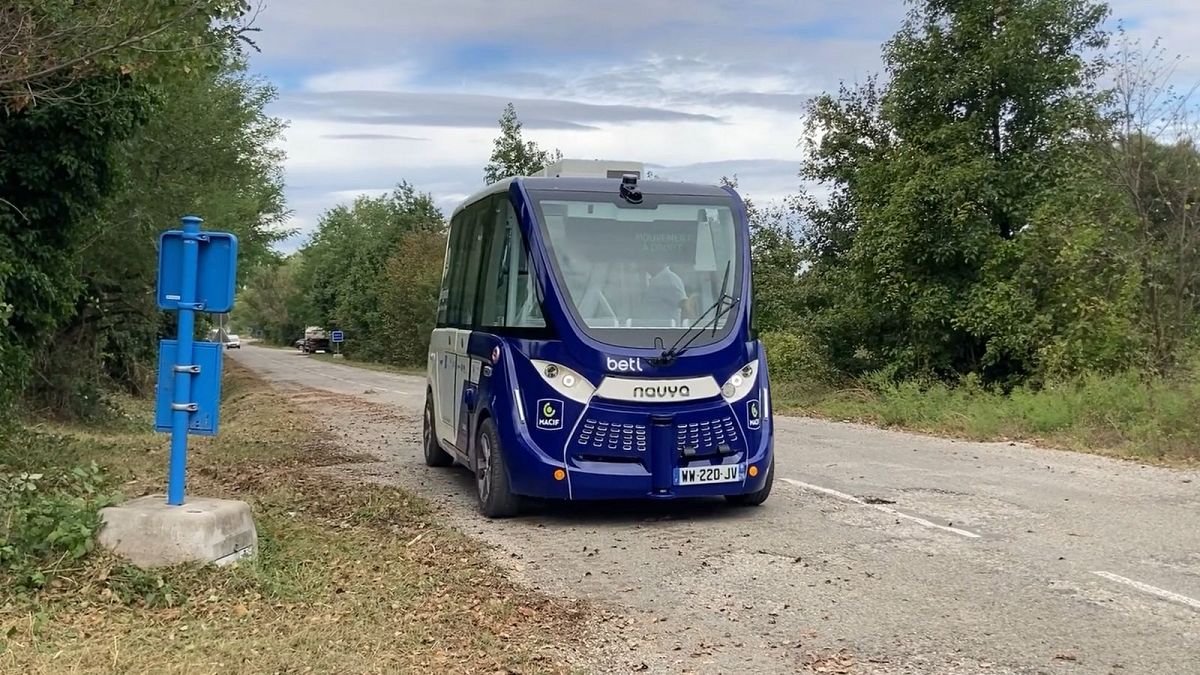This self-driving shuttle is being tested in rural France

Some say driverless vehicles are the future of mobility in rural areas but there are many challenges to address before they can be fully implemented.
Self-driving shuttles have been deployed in a remote region of southeastern France amid growing European interest in automated electric vehicles (EVs) as an option for public transport.
“We are trying to ensure that this is a new means of travel and mobility for people living in suburban or rural areas,” Yann Arnaud, director of responses to customer needs and innovation at the French insurance company MACIF, told Euronews Next on the sidelines of the European Mobility Expo.
The shuttles, which have been deployed since 2020, currently use a path of around 5 km with seven stops over 20 minutes with a control operator present to ensure a swift journey.
“We guarantee safety through a technology that is in line with the European vision of what an automated vehicle should be, so a vehicle that has learnt its route before operating it and which, when it is in operation and without a driver on board, simply compares what it has learnt with what it sees,” said Benjamin Beaudet, general director at Beti, the operator of the automated shuttles.
He drew a comparison to US and Chinese companies that have focused more on self-driving taxis, which don’t have predefined routes, with leading companies being Waymo (owned by Alphabet, Google’s parent company), Uber, and Tesla.
A solution for sparsely populated zones
The shuttle is being tested in a group of towns called Val de Drôme – Crest where the population density is 68 inhabitants per square km, lower than the French average of 106.
Those behind the shuttle say they have had positive feedback from its early users.
“Today, we are providing a service for people who are deprived of some of their mobility or for whom it is very difficult to get around,” said Arnaud from MACIF, which has acquired a stake in the automated vehicle operator.
“The question of acceptability arises when you have the luxury of having other options. When you don’t have a choice, you’re very happy to have [the shuttle],” he added.
Experts say driverless vehicles are a promising option for greener mobility in sparsely populated areas and can address the last leg of travel which involves getting a passenger from a transport hub to their destination.
This is seen as an area that can pose a challenge to reducing car use.
Three European seniors out of 10, for example, have reported a lack of services and infrastructure when it comes to mobility.
Other European initiatives have included AVENUE (Autonomous Vehicles to Evolve to a New Urban Experience), a project which began experimenting with self-driving vehicles in 2018.
Pilot projects were organised in Lyon, France as well as in Luxembourg, Geneva and Copenhagen.
Another project, SHOW (for SHared automation Operating models for Worldwide adoption) has been ongoing since 2020 and has had demonstrations in 20 cities in Europe, including Crest in the Drôme.
Costs and other challenges
The next steps in France are to increase the shuttles’ speed and to shift from a pilot programme to a more permanent offer.
The shift to providing the automated vehicle permanently is often challenging with few projects achieving commercial viability.
An open letter published in 2023 highlighted the logistics, technology and infrastructure issues that have prevented pilot programmes from being used on a larger scale.
These include the lifetime of driverless vehicles, the need for an updated high-definition mapping of the environment, and having a sufficient fleet, which represents a massive investment.
Overall, the EU has spent €159 million in research and innovation related to automated mobility since 2021.
World News || Latest News || U.S. News
Source link



